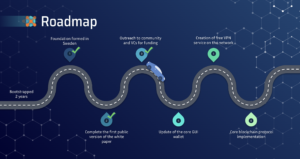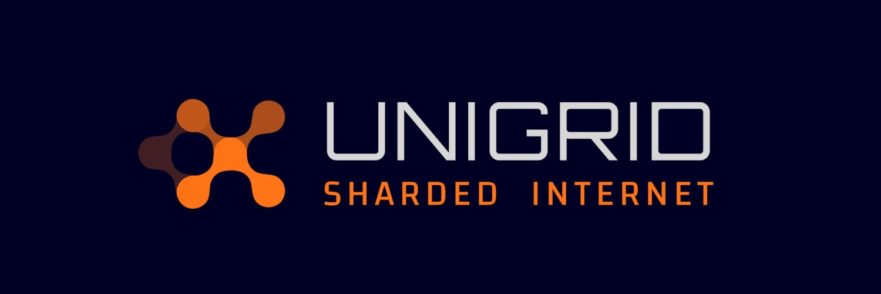The Unigrid Network is the first decentralized internet-based network that offers anonymity and security by design. The segmented design, featuring sharding, data striping and parity blocks, creates a network that protects against service disruption and data loss.
To ensure the network’s stability, the founding members have decided to open up a sale portal for anyone who wants to contribute. The sale portal is located at https://sale.unigrid.org
Unigrid
Currently, large, multinational conglomerates dominate the current Internet. Companies like Google, Microsoft, and Amazon have vast market shares, with Amazon Web Service owning more around 32% of the cloud infrastructure services market. This means that most of the Internet’s data is stored on servers owned by a handful of large entities. As a consequence of this conglomerate, routes and access to data are often overloaded during peak hours. The resulting degradation in the performance of the Internet can make it difficult for users to access data or services.
To solve this, Unigrid is a dynamic, distributed, content-centric network and a new architecture for the Internet, which is designed to be censorship-resistant. The Unigrid network is decentralized and self-organizing, and it will eliminate many current problems with centralized networks. Unigrid provides a high level of performance and redundancy at a low cost of ownership.
By creating a framework for an internet that is both highly available and very hard to censor, the Unigrid foundation is creating a more robust set of tools for the private sector to rely on for commerce, communication, and information sharing. The resulting economic benefit will positively impact governments that do not employ censorship tactics against their citizens.
- Decentralized Network and Gridnodes – Unigrid operates as a decentralized network, spreading functionality across many nodes, called Gridnodes. Each node has independent decision-making power and contributes to a pool of computing resources. If one node goes down or is compromised, the rest of the network will not be adversely affected. Gridnodes are one of the basic building blocks in a Unigrid computing environment. They provide storage space, communication channels, and compute cycles to the rest of the Unigrid network.
- Data Integrity – Unigrid uses a distributed ledger to record and verify the data collected by sensors. It provides a tamper-proof, decentralized and trustless method of verifying the integrity of data transmitted between two parties. The blockchain network plays a crucial role in securing the system and functions as an immutable ledger of events with no central authority. Function execution environments are responsible for managing virtual machines (VMs) on distributed systems and executing programs written in multiple programming languages.
- Side Chains and Resource Optimization – The key to the Unigrid network is its ability to scale out in a decentralized and cost-effective manner. The idea is to create side chains that can handle specific workloads, such as data storage, processing, or prioritizing transactions. Each side chain will have a set of dedicated nodes that will process the workload and communicate with other side chains. There are two types of side chains — primary and secondary. A direct side-chain is created when a group of Gridnodes want to work together on a project. They form a blockchain, which they then use to connect with other blockchains by sending messages back and forth. This connection can be thought of as an interchain communication channel — a direct link between two blockchains that bypasses the rest of the grid.
The UNIGRID token is used to pay for resources that are consumed on the network, such as disk space or CPU cycles.
The UGD Token
The Unigrid Network relies on a new, immutable blockchain technology that creates a decentralized supercomputer to store data. The network is broken down into “Gridnodes”. These nodes are the storage units for the network and are rewarded in the Unigrid token (UGD) for their service on the network. The UGD token is a utility token used to approve requests on the network.
Gridnode owners will use the UGD token to pay for services on the network such as storing data, performing computations on data, etc.
Gridnode owners will also charge users who wish to use their Gridnode to store data. In theory, this allows anyone with access to an internet connection and a computer to participate in the Unigrid Network and earn tokens by providing services or renting out their gridnode. To run a gridnode, users must stake an amount of UGD equal to the desired gridnode size. When more UGD are staked, the gridnodes created will benefit from a higher rank within the network and a greater chance of being selected when services are requested.
Token Distribution:
- (32,4%) 48,600,000 UGD – Foundation
- (4,27%) 6,400,000 UGD – Early Token Holders
- (13,33%) 20,000,000 UGD – First Sale Round (Dec 2021)
- (23,33%) 35,000,000 UGD – Second Sale Round (Q4 2022)
- (26,67%) 40,000,000 UGD – Public Sale Round (Q2-Q4 2023)
Total supply: 150,000,000 UGD
The 95,000,000 Sale tokens will unlock over a 1-year vesting schedule. Any unsold tokens will be put under the discretion of the Foundation and taken out of the circulating supply.
The Team
Adam Waldenberg – Co-Founder: Adam is an experienced software developer and entrepreneur. Trained at Chalmers University of Technology in computer science and interaction design, he has been a teacher at the same institution.
Evan Green – Co-Founder: Evan Studied interactive design and art at the Atlanta College of Art and SCAD. Over 20 years, developed web, mobile and desktop applications for companies such as EA, Levi’s, Activision, Microsoft and Starbucks.
Aaron Konkol – Business Advisor: A graduate of The University of Wisconsin-Madison, Aaron has held various roles in the enterprise software space. From leading engineering and product teams at startup companies to delivering applications for Bridgestone-Firestone, Harley-Davidson and Northwestern Mutual.

Major Upcoming developments
Decentralize NFT project: The team is planning to release an NFT project with a series of limited-edition tokens minted every month. Each token will be based on the Unigrid Foundation’s journey to build a sharded internet. Collecting all NFTs will give users a complete view of the Unigrid ecosystem and show how it evolved. The ability to trade these tokens also adds value to each one, as a rarer NFT is more valuable than a common one.
The Foundation has chosen to use Polygon as the initial platform for this because they are using an entirely new way of doing ERC721s that lets users mint their own token without having to pay high gas fees. We believe this could be very popular in the future among other projects that want to add more variety to their offerings.
Overview
- Name: Unigrid
- Presale Status: Live
- Sale Start Date: December 10th, 2021
- Sale End Date: December 31st, 2021
- Token Ticker: UGD
- Website: https://www.unigrid.org/
- KYC: Yes
More information on Unigrid is available in the Whitepaper, accessible here. More about Unigrid on the website unigrid.org. Follow@ on Twitter, or join the Telegram group to stay informed of the project’s latest developments.
Disclaimer: This Press Release was sponsored by the Unigrid Foundation. ICO Hot List does not endorse or recommend participating in any initial coin offerings. ICO Hot List has received compensation from the Unigrid Foundation to be featured in this article.

